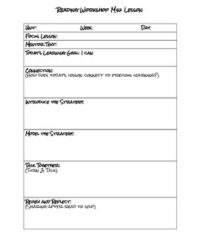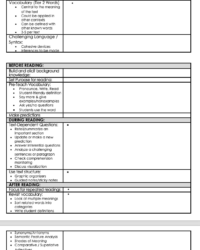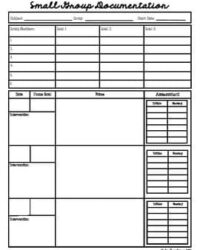Navigating the world of reading intervention can sometimes feel like trying to piece together a complex puzzle. Every student brings unique challenges, whether it’s decoding difficulties, comprehension struggles, or fluency issues. As educators, our goal is to provide targeted, effective support that truly helps these learners bridge the gap and blossom into confident readers. But how do we ensure consistency, track progress, and make the most of every precious minute of intervention time?
That’s where the magic of a well-structured reading intervention lesson plan template comes into play. It’s not just another piece of paperwork; it’s a powerful tool that brings organization, intentionality, and clarity to your intervention sessions. Think of it as your roadmap, ensuring every lesson builds purposefully on the last, addressing specific student needs with precision and confidence.
Why a Structured Reading Intervention Plan is Crucial
When you’re working with students who need extra support in reading, every minute counts. Without a clear plan, it’s easy for sessions to drift, important skills to be overlooked, or progress to become difficult to measure. A structured approach, guided by a robust reading intervention lesson plan template, ensures that your instruction is deliberate, data-driven, and truly impactful. It helps you stay focused on the student’s specific deficit areas and implement strategies with fidelity.
Imagine the difference between walking into a session with a vague idea of what to do versus having a step-by-step guide tailored to a student’s precise needs. A template forces us to think critically about our objectives, the materials we’ll use, and how we’ll assess understanding. This level of preparation not only makes our teaching more effective but also builds our confidence, knowing we’re providing the best possible support.
Many educators feel overwhelmed by the sheer number of reading skills that need addressing. From phonological awareness to vocabulary, fluency to comprehension strategies, it can feel like a lot to juggle. A comprehensive template acts as a checklist, ensuring that you’re consistently hitting all the vital components of a balanced reading intervention. It helps prevent those moments where you realize you’ve spent too much time on one skill and neglected another equally important one.
Ultimately, a well-designed plan benefits everyone involved. Students receive consistent, high-quality instruction, leading to greater progress and reduced frustration. Educators feel more organized, less stressed, and more effective in their practice. Parents can see a clear picture of the support their child is receiving, fostering better home-school communication.
Key Components to Include
So, what exactly should go into your ideal template? While every student is unique, certain foundational elements will make your plan robust and effective. These components help you cover all bases and ensure a holistic approach to reading intervention.
- Student Profile/Background: Basic information, diagnosed reading difficulties, strengths, and previous assessment data.
- Specific Learning Objective(s): Clear, measurable (SMART) goals for the session, directly tied to the student’s individual needs (e.g., “Student will accurately decode CVC words with short ‘a’ sounds at 80% accuracy.”).
- Materials Needed: A list of books, manipulatives, worksheets, or digital tools required for the lesson.
- Warm-Up/Review: A quick activity to engage the student and review previously taught skills.
- Direct Instruction: Explicit teaching of the new skill or strategy.
- Guided Practice: Opportunities for the student to practice the new skill with teacher support and immediate feedback.
- Independent Practice: Activities for the student to apply the skill on their own.
- Assessment/Check for Understanding: How you’ll measure if the objective was met (e.g., quick informal assessment, observation, exit ticket).
- Differentiation/Extensions: Notes on how to adjust the lesson for varying levels of support or for advanced learners.
- Next Steps/Homework: What the student will work on next or what practice they can do at home.
Tailoring Your Approach
While a template provides structure, remember that it’s a dynamic tool. It should be flexible enough to be adapted to each student’s evolving needs. Consider adding sections for notes on student responses, successes, challenges, and any unexpected discoveries during the session. This ongoing reflection is vital for refining your intervention strategies and ensuring continued progress.
Crafting Your Effective Reading Intervention Lesson Plan Template
Building your own effective reading intervention lesson plan template doesn’t have to be daunting. You can start with a basic framework and then customize it based on your students’ needs and your teaching style. The key is to make it practical and easy to use, something that genuinely streamlines your planning process rather than adding to your workload. Think about the flow of a typical intervention session and build your template around that natural progression.
As you use your template, you’ll naturally discover what works best for you and your students. Don’t be afraid to tweak it, add new sections, or remove ones that aren’t serving their purpose. It’s an iterative process. Perhaps you find that adding a “Social-Emotional Check-in” section at the beginning of each lesson significantly improves student engagement, or that a dedicated space for “Teacher Reflections” helps you plan more effectively for future sessions. Your template should evolve with your practice.
Ultimately, the goal of any reading intervention lesson plan template is to provide clarity and focus, allowing you to dedicate more of your energy to teaching and less to planning from scratch each time. It ensures that every student, regardless of their starting point, receives consistent, high-quality, and targeted support designed to unlock their full reading potential.
- Define the specific reading deficit for each student or group.
- Align objectives with recognized reading strategies (e.g., phonics, phonemic awareness, fluency, vocabulary, comprehension).
- Choose evidence-based intervention strategies that directly address the identified deficits.
- Incorporate opportunities for explicit instruction, modeling, guided practice, and independent application.
- Plan for ongoing, informal assessment within each lesson to monitor progress.
- Include space for data tracking to inform future instructional decisions.
Having a solid framework like a well-designed reading intervention lesson plan template in your toolkit can transform your approach to supporting struggling readers. It brings order to what can sometimes feel like chaos, ensuring that every instructional moment is purposeful and every strategy is aligned with a clear objective. This deliberate planning empowers you to deliver truly impactful lessons, fostering growth and confidence in your students as they navigate the exciting world of literacy.
By investing time in creating or adapting a template that truly works for you, you’re not just organizing your paperwork; you’re building a foundation for consistent, effective, and ultimately successful reading intervention. It allows you to focus on the heart of teaching: connecting with your students and guiding them toward their full potential, one carefully planned lesson at a time.


